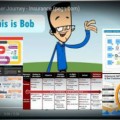I am seeing a new trend in the last while. More and more entrepreneurs are incorporating a community aspect to their product and marketing tactics. Personally, I think it’s brilliant.
Aside from the social benefits it can bring, I like it because, if done right, it is also profitable.
Community marketing is definitely not new and is used regularly by non-profit organisations. Until recently however, I had not seen start-ups and small businesses use it much, most likely because of the logistics costs involved. Social media platforms, new technologies and applications are now reducing these costs significantly, thus making community marketing a viable option.
What is community marketing?
Community marketing is a set of tactics used to involve your customers and/or prospect customers (subsets or all of them) and their network with your organisation.
What I very much like about community marketing is that it is based on what I perceive as the guiding principle of any company; answering its customers’ needs. Just to be clear here, I am not necessarily talking about the same needs your product/service is answering. Community marketing can answer needs that have nothing to do with your offering. As long as you succeed in scratching an itch for your customers then you are on the right track.
Community marketing can be done on any scale. Whether you are a start-up, a non-profit organisation, a public organisation or a multi-national there is an abundance of tactics to be used.
Community marketing tactics present great opportunities for co-marketing activities (marketing other brands alongside yours). It can also be used as a catalyst for a company to build a community of its own with other organisations.
Examples of community marketing tactics you can do are:
- Host regular meetups or trainings given by customers for other customers
- Charter a bus to an event your customers will want to attend
- Organise an online game tournament for your customers and their friends and family, where more highly skilled players are teamed with beginners to teach them or help them improve their skills
- Organise the cleanup/beautification of a park or area chosen by your customers
- Invite a group of customers to be employee for a day at your organisation or simply have an open house day with planned group activities
- Ask your customers and their network to help answer the needs of one of your customers and/or someone close to them (such as sending a get well card to the sick child of one of your customers)
Community marketing tactics are usually coupled with promotional tactics such as discounts, preferential treatment or other offers to achieve specific business objectives.
You can also incorporate a form of community marketing in your product/service. You could, for example, offer a specific version of your product/service or a specific pricing when customers buy as a group. You can facilitate this by offering a community exchange platform on your website where customers and potential customers can exchange and organise themselves.(1)
Community marketing done right
In order for community marketing to benefit your organisation it has to be done the right way. Direct financial benefits to your company should not be the main goal, unless you are a non-profit organisation, to maximise the benefits of community marketing, . The main objective is to answer a specific need for as many of your users as possible (networking, transport, learning, cleaning up their environment, accessibility, etc.). The opportunities created by your activity can be used to achieve secondary goals of direct or indirect financial rewards for your organisation.
The more important the need you aim to answer in your customer segments, the better your results will be. Transparency is a key element in all of your community marketing efforts. Your customers will not mind when your company benefits from the marketing tactic as long as your announced objective is clearly attained and you do not hide any of the benefits your organisation is getting out of the activity.
Any attempts to benefit unduly from a community marketing tactic will damage your brand, reduce customer loyalty and could seriously harm your profitability. Unfortunately, it will also make your customer base weary of attempts at community marketing by any other for-profit organisation they deal with.
Benefits of community marketing
As you have probably already figured out, there are multiple benefits to community marketing other than direct and indirect sales.
- Positive brand association
Customers taking part in your community marketing activities, having their needs answered, will associate your brand with positive feelings and good value. - Community leadership
Establish your organisation as a community leader that initiates positive changes and make their environment a better place - Better insights into your customers’ needs driving innovation
Multiplying opportunities to be in contact with your customers will enable you to observe them regularly and better understand their needs. Your customers themselves will also feel more inclined to share their needs with you. This will help drive innovation in your organisation. - Reducing your marketing costs
Activity costs can be shared, if not entirely recovered, by partnering with other companies and organisations. - Free advertising
There is nothing like doing a good deed for your community to get a positive buzz going in social (and traditional) medias. There is also nothing wrong in tooting your own horn about it. - Feeling good about what you are doing
As entrepreneurs we don’t always have as much time as we would like to get involved in our community. Community marketing activities are also a way for entrepreneurs to leverage what they are building on a daily basis and share the benefits with others.
There are many more benefits, direct and indirect, related to community marketing. Now that you know how simple it is, why don’t you give it a try.
(1): If the idea of your customers exchanging with one another is making you shudder, it may be time to take action on your total customer experience.











